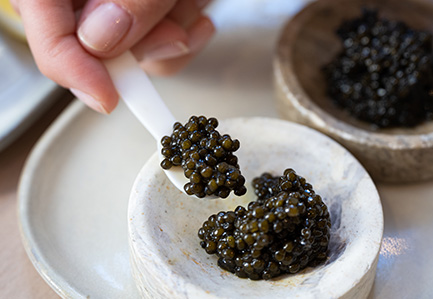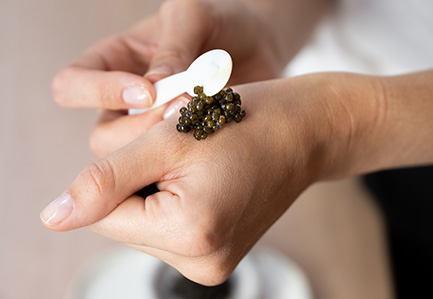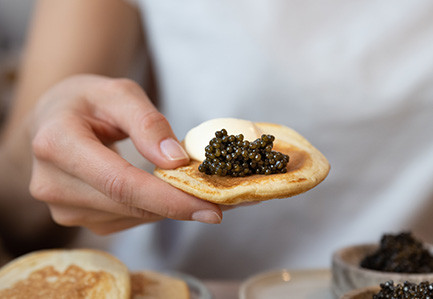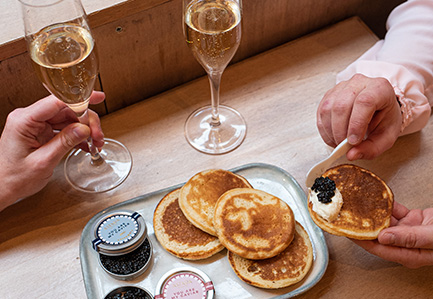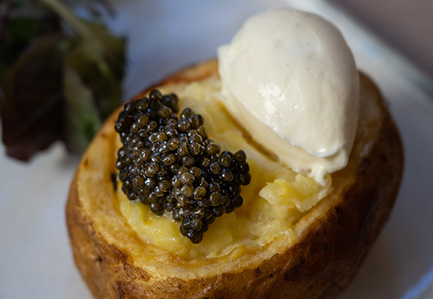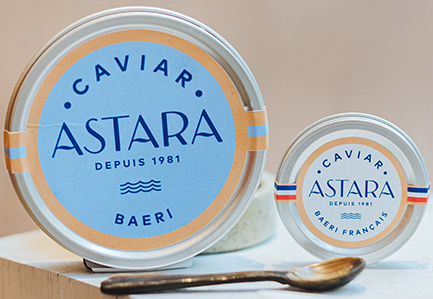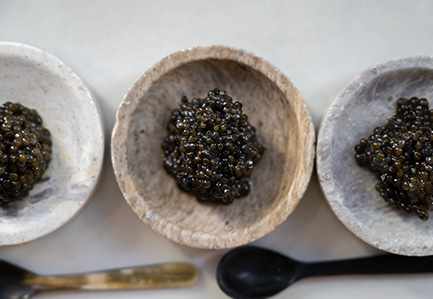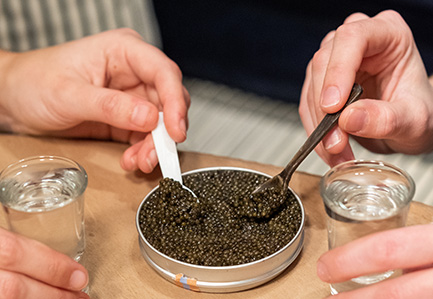How do you taste the caviar?

An exceptional product, caviar is often considered a symbol of luxury due to its rarity and prestigious origins. And yet, caviar has such a variety of sturgeon species, origins, flavors, that it has become a little more accessible and can now be tasted differently and simply.
But do you know the keys to a successful caviar tasting? Do you know what are the best practices to enjoy this exceptional dish? And what are the ideal drinks and accompaniments to reveal the flavours? This article will walk you through the essential tips fromAstara to find out how to taste black gold.
Whether you are a curious beginner or a caviar aficionado, let yourself be carried away by this exceptional taste journey to discover a product that never ceases to fascinate.
Golden rules for the perfect caviar appetizer
To guarantee an unforgettable experience, there are a few basic rules to follow when tasting caviar. These include maintaining caviar at an ideal temperature, choosing the right utensils for elegant presentation, and mastering a tasting technique that will allow you to fully appreciate the nuances of caviar.
The ideal temperature for caviar
A temperature of around 8°C is recommended to taste caviar, in order to highlight its subtle aromas and unique texture. Before serving, it is recommended to remove the caviar from the refrigerator and let it rest at room temperature for about ten minutes. To maintain its freshness during tasting, caviar should be served on a bed of ice, either in its original box or in a suitable container.
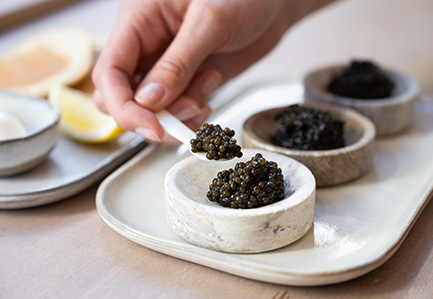
Recommended utensils for tasting caviar the right way
Caviar reacts poorly to contact with metal, which can change its flavour and promote oxidation. Thus, it is advisable to avoid the use of stainless steel or silver utensils, preferring instead mother-of-pearl, wood, plastic, porcelain or a horn spoon. We recommend eating caviar with a spoon in small quantities.
Tasting technique: How do you enjoy caviar?
Tasting black gold is an in-depth sensory experience, comparable to that of wine, which focuses on color, smell, texture, and taste.
Take a small amount of caviar with a spoon and smell it gently to appreciate its marine scent.
Then place the spoon on your tongue and let the kernels roll gently against your palate, feeling their tender, springy consistency.
Then let them pop gently to release their rich, nuanced flavor. Take your time to fully experience the unique sensations offered by caviar.
Accompaniments and drinks: Enhance the experience
Caviar is sufficient on its own, and is even more appreciated when it is combined with simple and discreet dishes that allow the caviar to take center stage. As for the drinks, discretion is also required, the objective being to complete the caviar tasting and not to overshadow it.
Here are tips for choosing the best sides and drinks.
The classics with caviar: Blinis and crème fraiche
Originally from Russia, blinis, small thick pancakes, go perfectly with caviar. Their sweetness and warmth contrast with the freshness and iodine of the caviar. Spread a little crème fraiche, butter or sour cream on a warm blini before crowning it with a spoonful of caviar.
Drinks to taste the caviar: Vodka or Champagne?
Traditionally, vodka is often associated with the tasting of caviar. Served ice-cold, it is eaten in small sips, interspersed between bites of caviar. Champagne, a symbol of French finesse, goes perfectly with caviar, favouring a brut or extra-brut. A dry, mineral white wine, such as Chablis or Sancerre, is also a great option.
Creative alternatives to caviar
For an original experience, pair caviar with unexpected dishes. A beef tartare brings contrast and boldness, while pasta dishes such as spaghetti or tagliatelle offer a neutral, melt-in-the-mouth base, ideal under caviar. Also explore recipes based on potatoes, baked, mashed or in salad, and enhanced with caviar, cream and fresh herbs.
Mistakes to avoid when serving caviar
Certain foods and beverages can compromise caviar enjoyment.
Avoid overly acidic, salty or spicy foods such as lemon, vinegar, cheese, smoked salmon or foie gras, which can mask caviar's delicate flavor.
The same goes for drinks that are too sweet, alcoholic or aromatic, such as whisky, cognac, port, red wine or sweet wine, which would saturate the palate.
Preliminary steps before tasting caviar
To be fully appreciated, tasting it requires you to follow certain essential preliminary steps. These steps include selecting the caviar that best suits your tastes and the occasion in view, as well as proper storage to maintain its superior quality.
Choosing the right caviar for your tastes and occasions
The choice of caviar is based on various factors such as species, origin, production process, as well as the size, color, texture and taste of the grains. The variety of caviars available at Astara offers a wide range of flavors and intensities.
For example, beluga caviar is considered among the most prestigious, known for its generously sized, light grey grains and rich, creamy taste. For a more affordable and fruity choice, baeri caviar, with its black, firm grains, is a great option. But for those looking for even rarer and more exclusive caviar, titanium caviar and platinum caviar offer an elite taste experience that will satisfy the most demanding palates.
Optimum caviar preservation for an unspoilt experience
Given its delicacy, caviar requires special attention in terms of conservation to preserve its optimal quality. It is advisable to store the box in the refrigerator, in its original hermetically sealed packaging, at a temperature ranging from 4°C to 8°C. It is also imperative to avoid any temperature fluctuations, exposure to light and oxidation, as these factors can deteriorate its flavor and texture. Caviar can usually be kept in the fridge for 8 weeks.
To serve the caviar, remove it from the fridge shortly before eating it so that it reaches approximately 8°C, the ideal temperature to reveal all the richness of flavors. Present it on a bed of ice, keeping its original container or transferring it to a suitable container, and use mother-of-pearl, wooden or plastic spoons that will not change its taste, unlike silverware.
Conclusion
You now have all the elements you need to orchestrate a successful caviar tasting. With these tips, you know how to select the right caviar for the occasion, store and serve the delicacy at the perfect temperature, enjoy it with the right utensils and the recommended tasting technique, and pair it with simple yet elegant accompaniments, while choosing the drinks that will echo the caviar.
You're ready to explore a memorable dining experience, one that promises to awaken your senses and make you rediscover caviar in a new light.
This moment of discovery is just a click away. Order your caviar now via our website to benefit from our exceptional promotions. Receive this exceptional product, guaranteed fresh and of the highest quality, at home. You are then free to organise your tasting moment as you see fit: alone, as a couple, with family or friends. Treat yourself to this unique gustatory pleasure, a moment of pure luxury and indulgence with caviar.
Frequently asked questions about caviar tasting
What kind of bread goes with caviar?
For the ultimate caviar experience, rye bread is the perfect choice. Its dense texture, slightly acidic taste and high nutritional value compared to white bread, make it the ideal accompaniment, without overshadowing the delicate nuances of caviar.
How much caviar per person?
The amount of caviar per guest will vary depending on the occasion and personal preference. It is advisable to serve between 15 and 20 grams per person, whether for a simple tasting, to accompany a dish or as a main course. Keep in mind to consume it neat for optimal taste authenticity, and keep it refrigerated until presented.
Why put caviar on your hand?
Putting a small amount of caviar on the back of the hand allows you to fully appreciate its taste without interference, while subtly warming it on contact with the skin. This refined practice, dating back to the era of the Tsars, offers a tasting experience known as "à la royale".
How to present caviar at the table?
Serve the caviar as soon as it opens, ideally over ice. Choose a mother-of-pearl, horn, wood or stainless steel spoon for serving, thus avoiding oxidation caused by other metals, especially silver.
If you liked this article containing all our advice on "How to enjoy caviar?", we invite you to consult our all-caviar party menu as well as our other articles about black gold.

